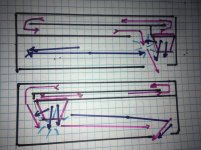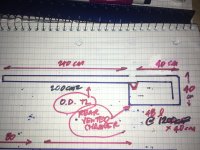If a bass reflex is designed such that the reflex port is a cut within the cabinet (hence its depth is same as that of the cabinet material thickness), can this port also positively contribute to controlling the directivity of the sound produced by the driver? Say, like a cardioid speaker?
Attachments
can this port also positively contribute to controlling the directivity of the sound produced by the driver?
I can not prove it with measurements at the moment, but I would definitely say yes to this. The port has to be large enough and there has to be the right relationship between air particle velocity and the size of the baffle surrounding the port.
See my HROAR builds for examples of what I consider "large enough port". The HROAR has a surprisingly narrow directivity for the port size.
See Danley Sound Labs BC415 and 412. Tom Danley does seem to use a large central placed port in a large baffle to "couple" the port radiation to the baffle area. I know this is a horn design, but the large port in the baffle is still a large cross section area port with "plywood-thickness-depth".
The problem is designing a driver suitable for this kind of bass reflex box - hence the horn or tapped pipe sections driving the large Helmholtz front resonator of those designs.
What is your reason for asking about directivity?
Because I wondered if the back wave coming out through the port, out of phase, would cancel some of the radiation coming from the front.
Yes, it does. This is why bass-reflex exhibits a 4th order deep bass roll off. Above that frequency, port radiation is in phase with the cone's direct output and is what provides the bass support of bass-reflex enclosures.
Because I wondered if the back wave coming out through the port, out of phase, would cancel some of the radiation coming from the front.
Ken Newton explained the basic concept nicely. The waves do indeed interact... and wouldn't it be wonderful if the phase relationship were magically reversed and you had addition below the tuning point.
But - as per my musings about dealing with the back wave - when I made a 17 foot labyrinth, I put the exit port almost 8 feet from the driver so both could be in corners and mix-and-match the phases, as you ask about.
Long pipe to sequester rear wave
So, maybe you have a good question there for folks to consider.
B.
Last edited:
A simple bass reflex port on the front of the cabinet as depicted in the OP will have no effect on the directivity of the enclosure, "out of phase" contributions from the port result in a series of peaks and dips well above the port's tuning (Fb).If a bass reflex is designed such that the reflex port is a cut within the cabinet (hence its depth is same as that of the cabinet material thickness), can this port also positively contribute to controlling the directivity of the sound produced by the driver? Say, like a cardioid speaker?
Passive cardioid designs using a single transducer and amplifier are possible, David Gunness has designed quite a line of them.
They are able to control directivity far better than I would have thought possible before I heard them at the 2017 Orlando InfoComm. The rear rejection was quite amazing for the size, bringing pattern control to low frequencies in cabinets that can be handled by one person and have good sensitivity.
David Gunness' (Fulcrum Acoustic,LLC) Patent No.: US 10,123,111 B2 from November 6, 2018 is a good introduction to the current (and past) state of the art in passive sub-cardioid technology.
https://www.fulcrum-acoustic.com/wp-content/uploads/2019/10/Passive-Cardioid-Speaker-Patent.pdf
Hydrophobic acoustically resistive cloth as used in cell phone mic protection helps make the process repeatable (around 38:55):
How Dave Gunness Finally Cracked the Code on Passive Cardioid Subwoofers - YouTube
Art
This is way better than my ‘drawing’ depicts. An aperture or shaped end. All i drew was a pinch point. im assuming we are thinking similar but youve defined it much better?
Another drastic way this other sketch maybe? Phase change at Fb? Bass reflex vent into a qw pipe ‘reflector’?? Sized into some harmonic lengths of each.
Ffrequently I consider a pair of floorstsnding mains using MtM (qw Pipe) and a separate ‘subwoofer’ section in the bottom section (qw pipe) which intermingled at a vent exit and all this made me apprehensive. Maybe Giri has a similar conundrum
Attachments
I can not prove it with measurements at the moment, but I would definitely say yes to this. The port has to be large enough and there has to be the right relationship between air particle velocity and the size of the baffle surrounding the port.
See my HROAR builds for examples of what I consider "large enough port". The HROAR has a surprisingly narrow directivity for the port size.
See Danley Sound Labs BC415 and 412. Tom Danley does seem to use a large central placed port in a large baffle to "couple" the port radiation to the baffle area. I know this is a horn design, but the large port in the baffle is still a large cross section area port with "plywood-thickness-depth".
The problem is designing a driver suitable for this kind of bass reflex box - hence the horn or tapped pipe sections driving the large Helmholtz front resonator of those designs.
Yes, it does. This is why bass-reflex exhibits a 4th order deep bass roll off. Above that frequency, port radiation is in phase with the cone's direct output and is what provides the bass support of bass-reflex enclosures.
Ken Newton explained the basic concept nicely. The waves do indeed interact... and wouldn't it be wonderful if the phase relationship were magically reversed and you had addition below the tuning point.
But - as per my musings about dealing with the back wave - when I made a 17 foot labyrinth, I put the exit port almost 8 feet from the driver so both could be in corners and mix-and-match the phases, as you ask about.
Long pipe to sequester rear wave
So, maybe you have a good question there for folks to consider.
B.
I realise that when port takes over , the driver doesn't radiate much sound and vice-versa, near and around the tuning frequency. If there's a cancellation at higher frequencies is worth investigating.
A simple bass reflex port on the front of the cabinet as depicted in the OP will have no effect on the directivity of the enclosure, "out of phase" contributions from the port result in a series of peaks and dips well above the port's tuning (Fb).
Passive cardioid designs using a single transducer and amplifier are possible, David Gunness has designed quite a line of them.
They are able to control directivity far better than I would have thought possible before I heard them at the 2017 Orlando InfoComm. The rear rejection was quite amazing for the size, bringing pattern control to low frequencies in cabinets that can be handled by one person and have good sensitivity.
David Gunness' (Fulcrum Acoustic,LLC) Patent No.: US 10,123,111 B2 from November 6, 2018 is a good introduction to the current (and past) state of the art in passive sub-cardioid technology.
https://www.fulcrum-acoustic.com/wp-content/uploads/2019/10/Passive-Cardioid-Speaker-Patent.pdf
Hydrophobic acoustically resistive cloth as used in cell phone mic protection helps make the process repeatable (around 38:55):
How Dave Gunness Finally Cracked the Code on Passive Cardioid Subwoofers - YouTube
Art
Thanks. The patent is vaguely similar to what I was looking for.
Giri, i dont know if this looks familiar, but words and mechanisms or acoustical lingo of some specific things arent always my best areas 🙂 but the blue area might be what youre refering to?
Isn't that a Paraflex? Also, the drawings look familiar. Are you Paul Ryan?
yeAh, sorry. must have been your recent interest in those.. i assumed you might have been referring to the front output crossing the other like it does in these two designs in the qw length of a previous fundamental. (hroar or alt paraflex. very interesting creatures they are! i wish more people looked into the functions and unique ‘science’ of that in particular. 🙂
- Home
- Loudspeakers
- Subwoofers
- Reflex port for directivity control?


